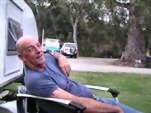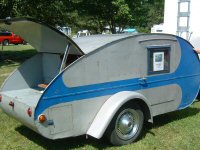Hi all. I am new to this forum but have spent many nights lurking and reading old posts. I am building a teardrop trailer and am in the design / materials purchase mode. I will note several of the choices I have made so far and materials I have acquired, and then pose some design questions.
* I have read in the Ecomodder Forum that the traditional teardrop design is not really as aerodynamic as it could be, so I am trying to design in aerodynamic features that are not associated with a traditional teardrop as seen in the TNTTT forum.
* I will pull this trailer with a 2004 Jetta TDI Sportwagen.
* I have acquired sheets of 5052 aluminum sheet with a clear anodized gloss finish that are 4 x 12 feet and 5 x 12 feet that I will use for the skin. I hope to attach this to the wood and foam frame using 3M double side ultra tape to minimize rivets.
* I have acquired a Harbor Freight trailer with 1720# capacity that I will stretch to be a 4x10 foot frame. I plan to skin the underside of the HF trailer with a sheet of continuous aluminum hiding the axle within the skin and place the axle on top the springs to lower the profile and reduce area under the trailer.
* I plan a Kamm back design using the Ecomodder AST II template for the top surface, running out to the 50% to 60% bulkhead. (In the attached picture count 4 to 5 sections from the point in the back. Picture a Toyota Prius with out the hood. Split the photo in half at the center line.
* The front of the trailer will lift up, hinged at the rear to increase headroom and interior space, while minimizing height while traveling. (Picture a car hood or hatchback.)
Now for the questions...
1. ? For the front of the trailer profile, I am thinking of several options.
a. try to recreate the shape of the rear of the Jetta, making the front of the trailer concave to try to match the convex profile of the rear door of the Jetta and matching the shape of the Jetta as seen from the rear. (although I wouldn't be able to run the trailer THAT close to the rear of the Jetta, this might allow the air stream of the Jetta to continue as if the Jetta and trailer were one aerodynamic unit)
b. make the front traditional with a rounded front like the leading edge of a wing and the sides of the trailer flat (very easy to construct with flat panels.)
c. use the superellipse or square half body plans documented by freebeard in the Ecomodder forum... (see attached... super ellipse in the center is more aerodynamic but the the square would be much easier to construct.)
d. try to reproduce schlorwagen shape and raise the top half of the trailer with pop up trailer jacks.
2. It there that great of a benefit to round / slope the trailer sides from bottom to top or are straight sides acceptable?
3. How great a benefit are rounded edges at the corners.
I thank you in advance for some discussion and apologize for my newbie questions :-)
Once I am further in the design process and make some decisions I will post some drawings and pictures...
Trying to create more aerodynamic design
45 posts
• Page 1 of 3 • 1, 2, 3
Re: Trying to create more aerodynamic design
Unless you are going to push it, rather than tow it, aerodynamics are almost a waste. This subject has been covered ad infinitum on the forum and our resident Engineer, Andrew to some, has given up. Your trailer will be traveling in dirty air all the time it is behind your vehicle. The best way to get better fuel efficiency is to have as small a gap as possible between both. If you can design a sleeve arrangement that fits onto the TV and the Trailer you will achieve the best efficiency.
With that said, let the debate begin
Cheers
Paul
With that said, let the debate begin

Cheers
Paul

Time is the only real capital we have. Money you can replace but time you cannot.
-

PaulC - 3rd Teardrop Club
- Posts: 4439
- Images: 36
- Joined: Mon May 24, 2004 7:27 am
- Location: Laura, SouthernFlinders Ranges, South Australia




